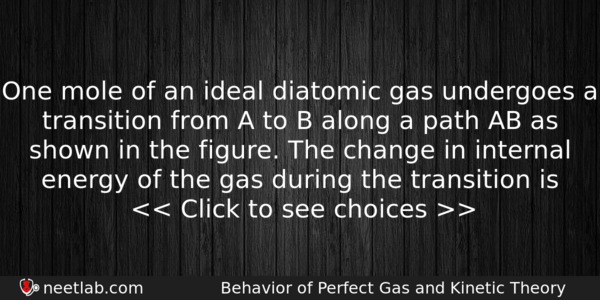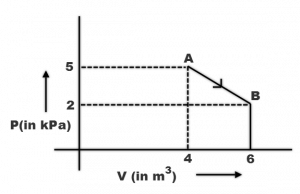| ⇦ | 
| ⇨ |
One mole of an ideal diatomic gas undergoes a transition from A to B along a path AB as shown in the figure.

The change in internal energy of the gas during the transition is
Options
(a) -20 kJ
(b) 20 J
(c) -12 kJ
(d) 20 kJ
Correct Answer:
-20 kJ
Explanation:
No explanation available. Be the first to write the explanation for this question by commenting below.
Related Questions: - An alternating voltage given as, V=100√2 sin100t V is applied to a capacitor
- A series L-C-R circuit contains inductance 5 mH, capacitance 2 μF and resistance
- A black body at a temperature of 227⁰C radiates heat at a rate of 20 cal m⁻²s⁻¹.
- A proton beam enters a magnetic field of 10⁻⁴ Wb/m² normally. If the specific charge
- The body of mass m hangs at one end of a string of length l, the other end of which
Topics: Behavior of Perfect Gas and Kinetic Theory
(34)
Subject: Physics
(2479)
Important MCQs Based on Medical Entrance Examinations To Improve Your NEET Score
- An alternating voltage given as, V=100√2 sin100t V is applied to a capacitor
- A series L-C-R circuit contains inductance 5 mH, capacitance 2 μF and resistance
- A black body at a temperature of 227⁰C radiates heat at a rate of 20 cal m⁻²s⁻¹.
- A proton beam enters a magnetic field of 10⁻⁴ Wb/m² normally. If the specific charge
- The body of mass m hangs at one end of a string of length l, the other end of which
Topics: Behavior of Perfect Gas and Kinetic Theory (34)
Subject: Physics (2479)
Important MCQs Based on Medical Entrance Examinations To Improve Your NEET Score
18000+ students are using NEETLab to improve their score. What about you?
Solve Previous Year MCQs, Mock Tests, Topicwise Practice Tests, Identify Weak Topics, Formula Flash cards and much more is available in NEETLab Android App to improve your NEET score.
Share this page with your friends

ΔU = nCΔT
Also, T = PV/nR
Now,
ΔT = T-T => [PV – PV] / nR
ΔU = nR/¥-1 {PV- PV / nR} [here, ¥ = gamma]
(nR will be cancelled out)
We get,
{-8 x 10^3} / {2/5} = -20kJ.
Hope it helps 🙂